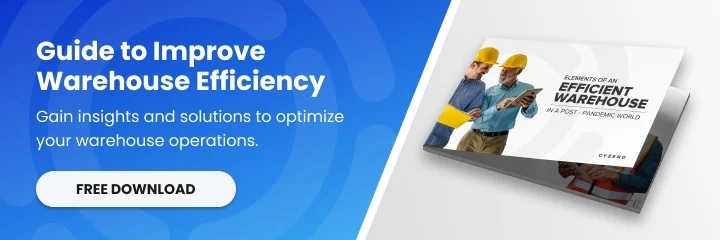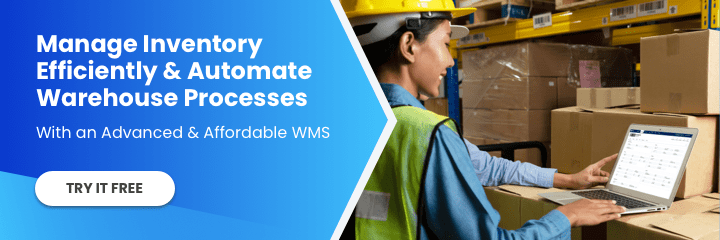For more information about reducing warehouse costs or the latest warehouse technology trends, you can follow us on LinkedIn, YouTube, X, or Facebook. If you have other inquiries or suggestions, please contact us here. We’ll be happy to hear from you.
There’s no doubt that we now live in a digital world, and businesses that can’t keep it up are at a disadvantage. The warehousing industry is no different.
The efficiency of warehouse operations directly influences its ability to satisfy customers and maintain a competitive edge. This shift has propelled Warehouse Management Systems (WMS) from traditional, on-site installations to flexible, cloud-based solutions known as WMS Software-as-a-Service (SaaS).
This transition offers small to mid-sized warehouses unprecedented access to scalable, cost-effective, and powerful tools to optimize their supply chain from end to end.
Click Here: Boost Your Warehouse Efficiency With This Advanced and Affordable WMS
This article will equip warehouse managers with the fundamentals of WMS SaaS, contrasting it with its traditional counterparts and unraveling its capacity to transform warehouse operations.
Discover how embracing WMS SaaS not only propels operational excellence but also ensures businesses are agile, responsive, and ready for the future of commerce.
What is WMS SaaS?
WMS SaaS stands for Warehouse Management Systems Software-as-a-Service. This type of WMS offers the advantage of being cloud-based, which means it is accessible anytime, anywhere, as long as there is an internet connection. This means businesses can have real-time visibility into their warehouse operations, regardless of their physical location, and be able to manage inventory, optimize order fulfillment, and achieve operational excellence. With the ability to access information on the go, decision-making becomes faster and more efficient.

Traditional vs. SaaS WMS
Traditional and SaaS WMS are used to manage and optimize warehouse operations, but they differ in deployment, cost structure, scalability, and maintenance. Here’s a breakdown of the differences between the two:
1. Deployment
- Traditional WMS: Traditional WMS systems are typically installed on-premises. This means that the software is installed on servers within the company’s physical infrastructure, and the company is responsible for maintaining and updating the software. This provides companies with direct control over the infrastructure and data.
- SaaS WMS: SaaS WMS is a cloud-based solution. The software is hosted on remote servers by a third-party provider, and users access it via the Internet. There is no need for on-premises installation, and users can access the system from anywhere with an internet connection.
2. Cost Structure
- Traditional WMS: Traditional WMS often involves higher upfront costs. Companies need to invest in hardware, software licenses, and IT infrastructure. Additionally, ongoing maintenance and support costs can add up over time.
- SaaS WMS: SaaS WMS typically follows a subscription-based pricing model. Users pay a recurring fee, which covers software usage, maintenance, updates, and support. This can make it more cost-effective for smaller businesses without a large upfront budget.
3. Scalability
- Traditional WMS: Scaling traditional WMS can be more complex and time-consuming. As the business grows or changes, companies might need to invest in additional hardware and resources to accommodate increased demand.
- SaaS WMS: SaaS WMS offers greater scalability. Cloud-based solutions can easily scale up or down based on business needs. Users can adjust their subscription plans to accommodate changes in warehouse size, order volume, and operational requirements.
4. Maintenance and Updates
- Traditional WMS: Companies using traditional WMS are responsible for maintaining and updating the software. This includes installing patches and updates and ensuring the system’s security.
- SaaS WMS: The SaaS provider handles maintenance and updates. This alleviates the burden on the company’s IT staff, as the provider ensures that the system is up-to-date, secure, and running smoothly.
5. Accessibility and Mobility
- Traditional WMS: Access to a traditional WMS might be limited to the physical location where the software is installed. Remote access might require complex setups like VPNs.
- SaaS WMS: SaaS WMS can be accessed from anywhere with an internet connection. This enhances mobility and allows authorized personnel to manage warehouse operations even off-site.
6. Implementation Time
- Traditional WMS: Implementing traditional WMS can take longer due to the need for hardware setup, software installation, and configuration.
- SaaS WMS: SaaS WMS typically has a faster implementation timeline since the infrastructure is already in place. Users can start using the system once they subscribe and configure their settings.
Benefits of WMS SaaS for Businesses
Now that we have a basic understanding of WMS SaaS let’s explore its wide-ranging benefits for businesses. From cost savings to enhanced visibility, WMS SaaS and its features greatly impact warehouse management.
1. Cost Savings
One of the most significant advantages of WMS SaaS is the cost savings it brings to businesses. With traditional on-premise systems, companies must invest in expensive hardware, software licenses, and ongoing maintenance. This not only requires a substantial upfront investment but also increases the total cost of ownership over time. In contrast, WMS SaaS eliminates the need for upfront capital expenditure and reduces ongoing maintenance costs. Businesses can simply pay a monthly or annual subscription fee based on their usage, making it a more affordable option.
2. Scalability
Furthermore, as mentioned earlier, WMS SaaS provides scalability. This means businesses can easily adjust their warehouse management capabilities as their needs change. Whether they need to accommodate seasonal fluctuations in demand or expand their operations, WMS SaaS allows businesses to scale up or down without needing additional hardware. This level of flexibility is crucial in today’s fast-paced business environment, where agility is key to success.
3. Enhanced Visibility
In the world of warehouse management, visibility is everything. Businesses need to know the exact location of their inventory, the status of their orders, and the performance of their warehouse operations. This is where WMS SaaS shines. By providing real-time visibility into inventory levels, order status, and overall warehouse performance, businesses can identify bottlenecks, make informed decisions, optimize processes, and ensure that inventory is always available to meet customer demand.
4. Accessibility
SaaS WMS is accessible from anywhere with an internet connection. This remote accessibility enables warehouse managers, employees, and even suppliers to access real-time information, whether on-site or off-site.
5. Increased Productivity
Another key benefit of WMS SaaS is its ability to streamline warehouse operations and increase productivity. With features such as automated workflow processes and intelligent task management, businesses can eliminate manual and repetitive tasks, reducing the chance of errors and improving overall efficiency.

6. Rapid Implementation
SaaS WMS solutions are already hosted in the cloud, eliminating the need for complex on-site installations. This leads to quicker implementation, allowing businesses to use the system sooner and realize benefits faster.
7. Automatic Updates
SaaS providers handle software updates and maintenance, ensuring the system is always up-to-date with the latest features and security enhancements. This reduces the burden on internal IT staff and ensures the system’s reliability.
8. Reduced IT Burden
With SaaS WMS, businesses don’t need to manage complex IT infrastructure or worry about server maintenance. This allows IT teams to focus on other strategic initiatives instead of routine system upkeep.
9. Faster ROI
Due to the faster implementation, reduced upfront costs, and improved operational efficiency, businesses using SaaS WMS can achieve a faster return on investment than traditional WMS solutions.
10. Integration Capabilities
A key advantage of WMS SaaS is its seamless integration capabilities with other systems. Traditional on-premise warehouse management systems often struggle to communicate with third-party applications, leading to manual data entry and potential errors. With WMS SaaS, businesses can integrate their warehouse management system with their customer relationship management (CRM) tool, enterprise resource planning (ERP) software, transportation management systems (TMS), and even their e-commerce platforms.
11. Multi-Site Management
For businesses with multiple warehouse locations, SaaS WMS offers centralized management and visibility across all sites. This simplifies operations by providing a unified view of inventory and processes.
12. Data Analytics
Many SaaS WMS solutions come with built-in analytics and reporting features. Businesses can analyze data related to warehouse performance, order trends, and inventory turnover to make informed decisions and improve processes.
13. Risk Mitigation
SaaS providers often have robust security measures, including data encryption, regular backups, and compliance with industry standards. This helps mitigate the risk of data breaches and other security concerns.
How to Choose the Right WMS SaaS Provider
Selecting the right WMS SaaS provider is crucial for the success of your warehouse management operations. With numerous providers in the market, it’s important to consider key factors such as the following:
1. Industry Expertise
First and foremost, they should evaluate the provider’s experience and expertise in the warehouse management industry. A reputable provider should have a deep understanding of warehouse operations, industry best practices, and the specific needs of different businesses.
2. Infrastructure and Security
Secondly, businesses should assess the provider’s technology stack and infrastructure. It is important to ensure that the provider offers a robust and secure cloud-based platform that can handle the demands of the business. Scalability, uptime, and data security should be top priorities when evaluating a provider’s infrastructure.
3. Customer Support
Thirdly, customer support is vital. Implementing and managing a WMS SaaS solution can be complex, and having reliable support from your provider is essential. Look for a provider that offers comprehensive customer support, including training, troubleshooting, and system updates. A responsive support team will address any issues or concerns promptly, minimizing disruptions to your warehouse operations.

4. Customer Reviews
Lastly, businesses should consider the provider’s track record and customer reviews. It is essential to choose a provider with a proven track record of delivering reliable and high-quality services. Reading customer reviews and testimonials can provide valuable insights into the provider’s customer service, support, and overall satisfaction.
Steps to Implement WMS SaaS in Your Warehouse
Implementing WMS SaaS in your warehouse requires careful planning and execution. Here are some key steps to consider when implementing a WMS SaaS solution:
Step 1: Assess your current warehouse processes
Before implementing WMS SaaS, evaluate your existing warehouse processes and identify areas for improvement. Understand your pain points and define your objectives for implementing a new system.
Step 2: Map out your requirements
Once you have identified your objectives, map out your specific requirements for the WMS SaaS solution. Consider inventory management, order fulfillment, picking and packing processes, and integration with other systems.
Step 3: Select a WMS SaaS provider
Based on your requirements, choose a WMS SaaS provider that aligns with your needs. Evaluate different providers, request demos, and consider factors such as system capabilities, ease of use, and pricing.
Step 4: Plan for data migration
Migrating data from your existing systems to the new WMS SaaS solution is a critical step. To avoid disruptions to your operations, ensure that you have a plan for data cleansing, mapping, and migration.
Step 5: Train your employees
Proper training ensures a smooth transition to the new WMS SaaS system. Train your employees on using the system effectively, including functionalities such as order processing, inventory management, and reporting.
Step 6: Monitor and optimize
Once the WMS SaaS system is implemented, continuously monitor its performance and gather employee feedback. Identify areas for improvement and work closely with your WMS SaaS provider to optimize the system based on your evolving needs.
By following these steps, you can successfully implement WMS SaaS in your warehouse and unlock the full potential of a cloud-based warehouse management solution.
Conclusion
In conclusion, WMS SaaS offers a scalable, flexible, and cost-effective solution for businesses looking to optimize their warehouse operations. From cost savings and scalability to enhanced visibility and streamlined operations, the benefits of WMS SaaS are undeniable. In addition, businesses can eliminate the need for in-house IT infrastructure and focus on their core competencies while enjoying the benefits of a state-of-the-art warehouse management solution.
WMS SaaS is revolutionizing how businesses manage their inventory, fulfill orders, and achieve operational excellence. By embracing this technology, businesses can stay ahead of the competition, enhance customer satisfaction, and achieve long-term success in today’s dynamic business landscape.












